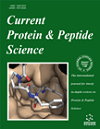- Home
- A-Z Publications
- Current Protein and Peptide Science
- Previous Issues
- Volume 16, Issue 2, 2015
Current Protein and Peptide Science - Volume 16, Issue 2, 2015
Volume 16, Issue 2, 2015
-
-
Polysaccharide-Protein Nanoassemblies: Novel Soft Materials for Biomedical and Biotechnological Applications
More LessAuthors: Juan P. Fuenzalida and Francisco M. GoycooleaPolysaccharide and proteins are the major constituent building blocks of biological systems and often occur as highly organized macromolecular architectures (e.g. the capsid of viruses). Both can occur in the same or in different biological physiological environment interacting in specific or non-specific ways. When isolated and purified, these macromolecules can harness self-assembled (SA) soft nanomaterials by non-covale Read More
-
-
-
Proteins for Breaking Barriers in Lignocellulosic Bioethanol Production
More LessReduction in fossil fuel consumption by using alternate sources of energy is a major challenge facing mankind in the coming decades. Bioethanol production using lignocellulosic biomass is the most viable option for addressing this challenge. Industrial bioconversion of lignocellulosic biomass, though possible now, is not economically viable due to presence of barriers that escalate the cost of production. As cellulose and hemic Read More
-
-
-
Amyloidogenicity of p53: A Hidden Link Between Protein Misfolding and Cancer
More LessAuthors: Hao Gong, Xin Yang, Yudan Zhao, Robert B. Petersen, Xinran Liu, Yang Liu and Kun HuangPathogenic aggregation is closely associated with various protein misfolding diseases such as type 2 diabetes mellitus and Alzheimer’;s disease. Amyloidogenic proteins that have a propensity to assemble into amyloid oligomers and fibrils form the aggregates. The tumor suppressor p53, a transcription factor that regulates the cell cycle and apoptosis, is also amyloidogenic. In tumor models, both wild type and mutant p53 p Read More
-
-
-
Proline-Rich Peptides: Multifunctional Bioactive Molecules as New Potential Therapeutic Drugs
More LessProline-rich peptides (PRPs) include a large and heterogeneous group of small-medium sized peptides characterized by the presence of proline residues often constituting peculiar sequences. This feature confers them a typical structure that determines the various biological functions endowed by these molecules. In particular the left-handed-polyproline-II helix is essential for the expression of the antimicrobial, immun Read More
-
-
-
The Molecular Basis for the Post-Translational Addition of Amino Acids by L/F Transferase in the N-End Rule Pathway
More LessAuthors: Angela Wai S. Fung and Richard P. FahlmanThe N-end rule pathway is a conserved targeted proteolytic process observed in organisms ranging from eubacteria to mammals. The N-end rule relates the metabolic stability of a protein to its N-terminal amino acid residue. The identity of the N-terminal amino acid residue is a primary degradation signal, often referred to as an N-degron, which is recognized by the components of the N-end rule when it is a destabilizing Read More
-
Volumes & issues
-
Volume 26 (2025)
-
Volume 25 (2024)
-
Volume 24 (2023)
-
Volume 23 (2022)
-
Volume 22 (2021)
-
Volume 21 (2020)
-
Volume 20 (2019)
-
Volume 19 (2018)
-
Volume 18 (2017)
-
Volume 17 (2016)
-
Volume 16 (2015)
-
Volume 15 (2014)
-
Volume 14 (2013)
-
Volume 13 (2012)
-
Volume 12 (2011)
-
Volume 11 (2010)
-
Volume 10 (2009)
-
Volume 9 (2008)
-
Volume 8 (2007)
-
Volume 7 (2006)
-
Volume 6 (2005)
-
Volume 5 (2004)
-
Volume 4 (2003)
-
Volume 3 (2002)
-
Volume 2 (2001)
-
Volume 1 (2000)
Most Read This Month
Article
content/journals/cpps
Journal
10
5
false
en


